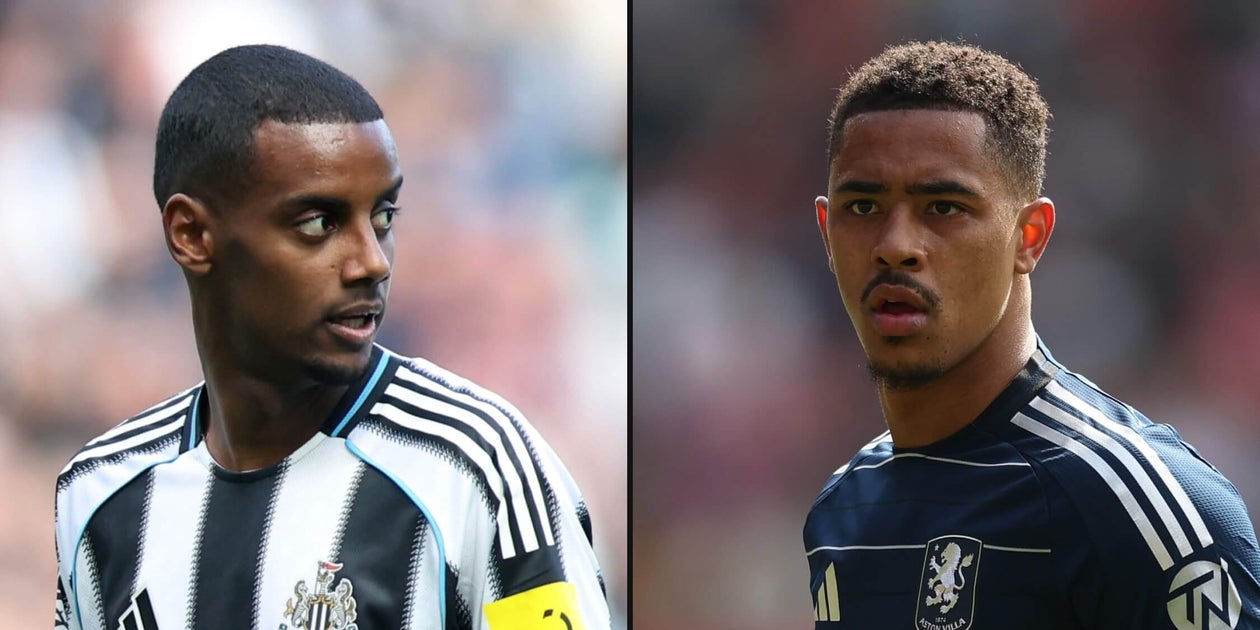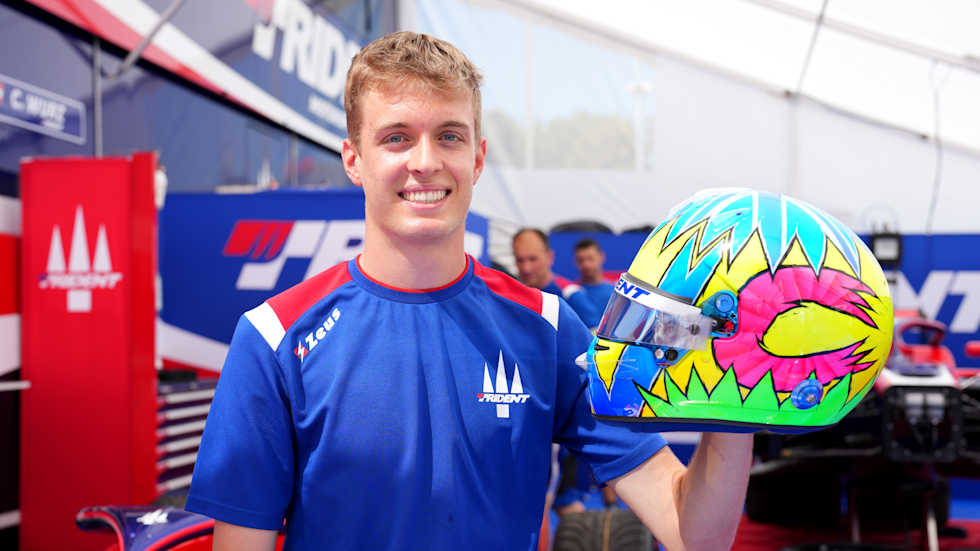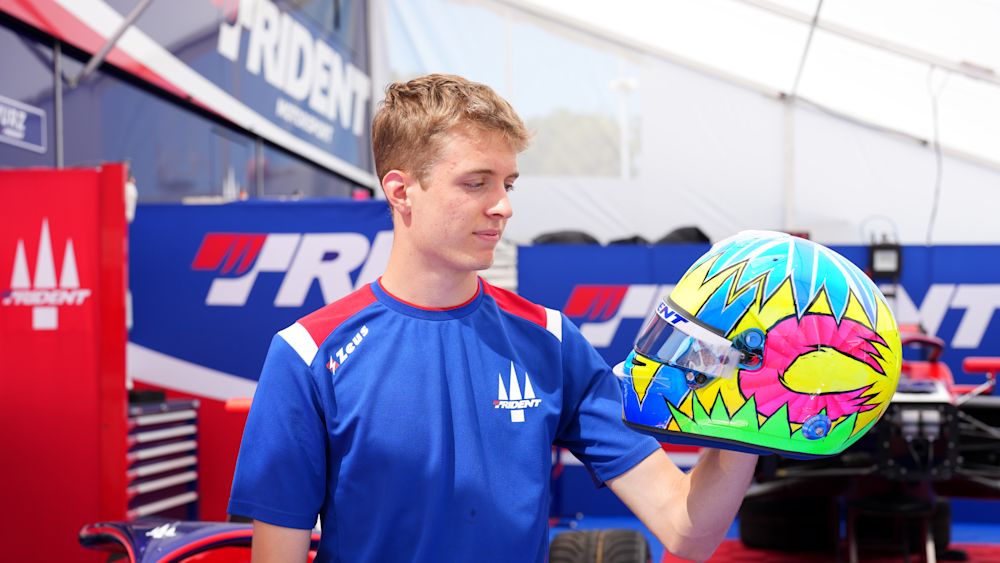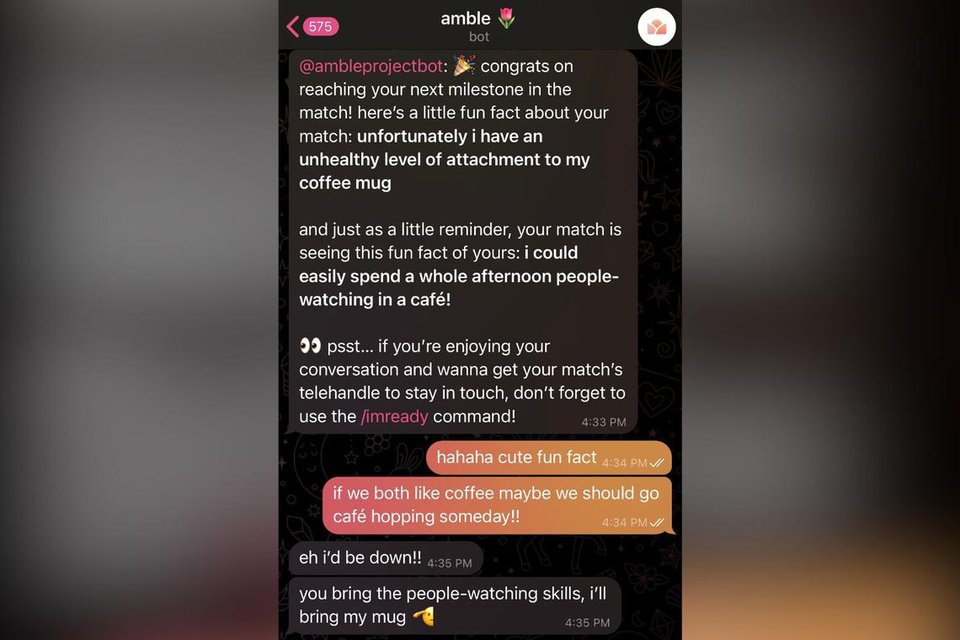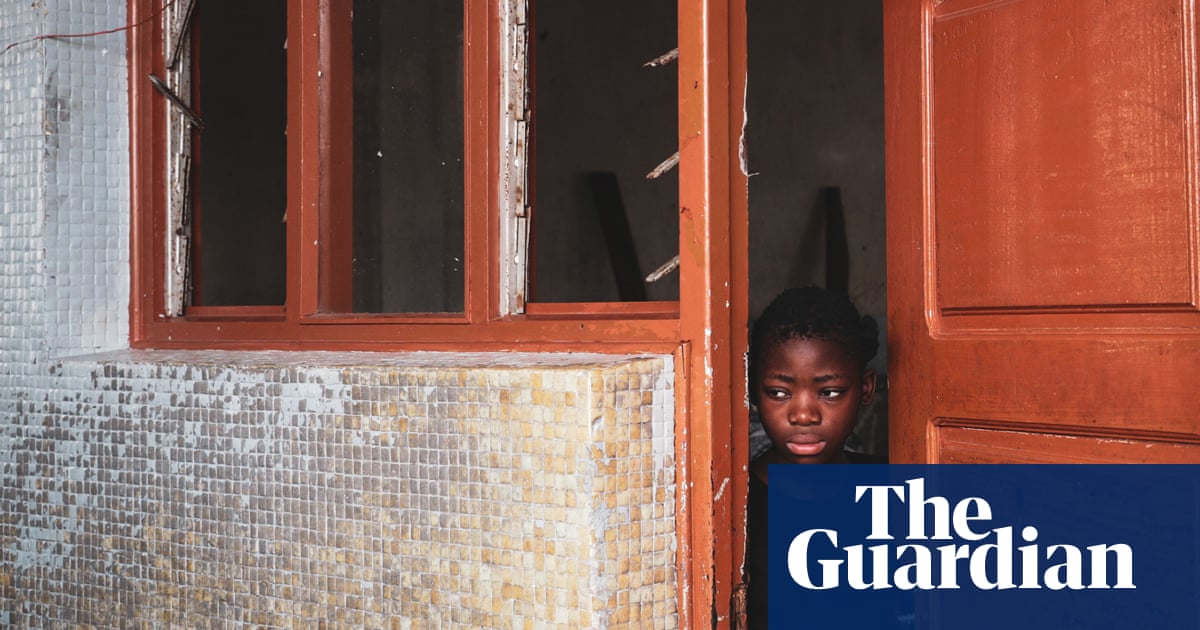Welcome to the 11th edition of The Athletic’s Transfer DealSheet for the summer 2025 transfer window.
Our team of dedicated writers, including David Ornstein, will take you inside the market to explain the deals being worked on. The transfer window is open and will run until September 1.
The information found within this article has been gathered according to The Athletic’s sourcing guidelines. Unless stated, our reporters have spoken to more than one person briefed on each deal before offering the clubs involved the opportunity to comment. Their responses, when they were given, have been included.
We aim to bring you analysis you can trust about what is happening at Europe’s leading clubs and the latest information we’re hearing from across the market. This year, The Athletic’s football finance writer, Chris Weatherspoon, will be adding to our analysis of the transfer market. Our Manchester City reporter Jordan Campbell will return with the latest from the club next week.
Last week, we looked at the striker high among the options left on the market, a possible deal for an Arsenal midfielder, and the latest on Benjamin Sesko before he joined Manchester United. This week, David Ornstein gives us his One To Watch, we have news on Liverpool’s interest in a young defender and the latest on Gianluigi Donnarumma.
This article is long but detailed, so enjoy it all — or search for the club or player you want to read about.
David Ornstein’s One To Watch
When supporters are awaiting Newcastle United’s line-up to face Aston Villa on Saturday, a burning question will be what role — if any — Alexander Isak might occupy for Eddie Howe’s team.
Isak has not featured in pre-season amid Liverpool’s ongoing pursuit, and while Newcastle have stressed they have no intention of allowing a sale, potential replacements continue to be explored.
The anticipation is that Isak will miss the trip to Villa Park, with his future shrouded in uncertainty. Based on conversations with sources privy to the matter, The Athletic understands Isak is adamant he will never represent Newcastle again.
Even if Newcastle refuse to sell the 25-year-old Sweden striker and he remains on Tyneside when the transfer window closes, Isak regards his career at St James’s Park as finished and has no desire to reintegrate into the squad.
Isak may have played his last game in a Newcastle shirt (George Wood/Getty Images)
Isak’s perspective is that, after being informed last summer that a new contract would not yet be offered to him — because of Newcastle’s need to comply with football’s financial rules and Isak already having a lucrative deal until 2028 — he made clear it would be his last campaign with the club.
Some at Newcastle deny that this was expressed and believe the forward planned to discuss the situation, including the possibility of fresh terms, once 2024-25 concluded.
Last campaign, Isak helped his side win the Carabao Cup and qualify for the Champions League. Two weeks before the season ended, he told Howe of his wish to leave and reiterated this on a call to the manager before flying to Sweden after the club’s final-day defeat by Everton.
Liverpool are yet to make another offer since their £110million bid at the beginning of August was turned down. Newcastle’s stance may soften if a proposal closer to £150m arrives and they can fill Isak’s void through the market.
The Premier League champions’ interest remains firm, and Isak is focused on a move to Anfield.
Keep an eye on Ramsey…
Another situation to watch as the transfer window enters its final few weeks involves Aston Villa midfielder Jacob Ramsey.
The 24-year-old is now in the final 24 months of his Villa contract, and despite several offers to extend, no agreement has been reached. In such circumstances, both parties are open-minded about finding an alternative solution, and that is likely to mean a sale.
This would avoid further limbo, allowing Villa to plan ahead with more clarity and Ramsey the opportunity to achieve greater career stability. Many suitors have expressed an interest to Ramsey’s camp, but emerging as his preferred destination are Newcastle United.
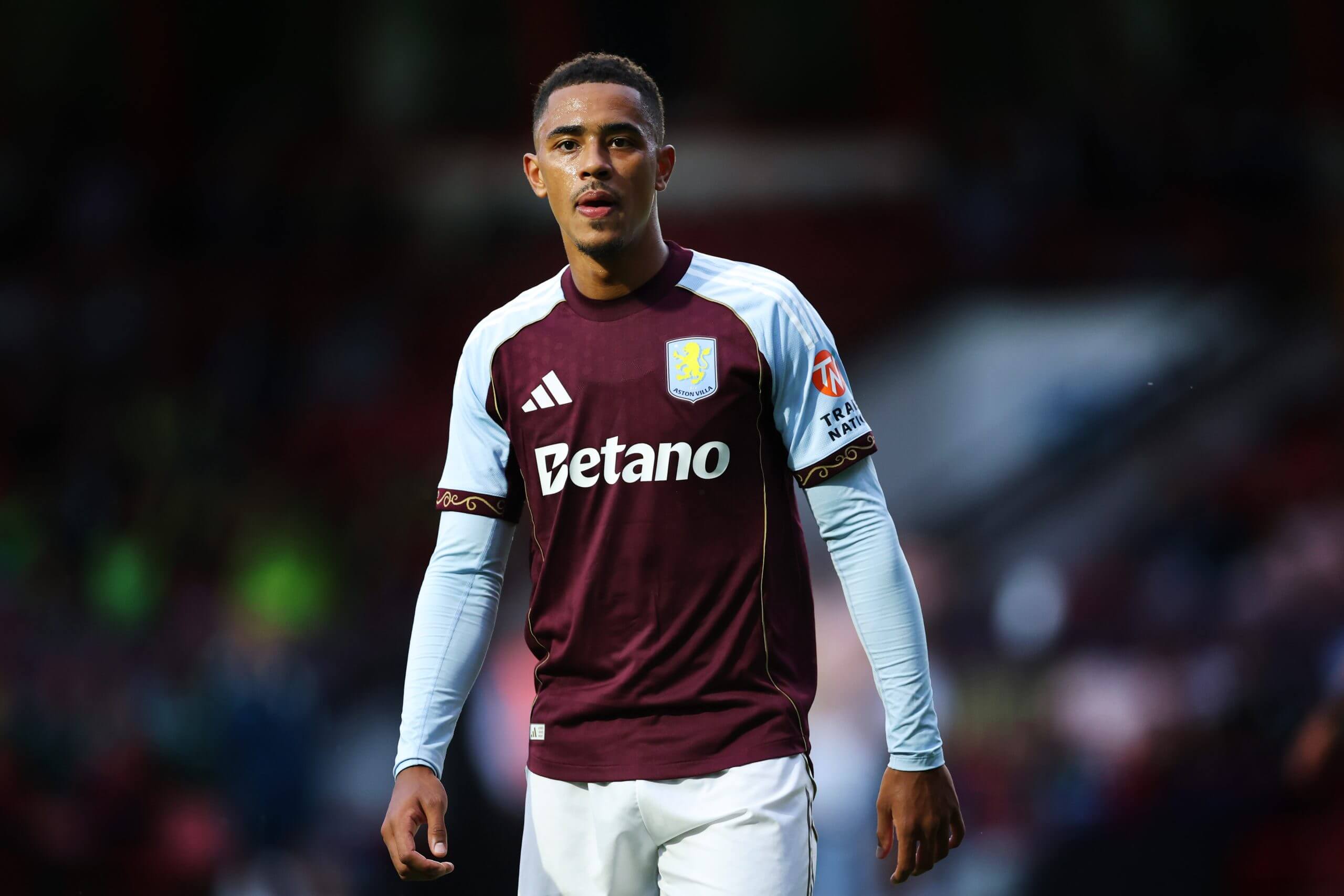
Ramsey has made 167 appearances for Villa (Dan Istitene/Getty Images)
The Tyneside club made an approach for the former England youth international in January 2024, and boss Eddie Howe is a big fan.
Other sides from the Premier League and abroad are also keen, including West Ham United. Their head coach Graham Potter admires Ramsey, and the feeling is mutual. However, Newcastle’s project and the chance to work under Howe are thought to carry the greatest appeal.
Before opening their seasons in Saturday’s lunchtime kick-off at Villa Park, Newcastle and Villa are starting talks to explore whether a compromise can be reached.
Ramsey is a priority target as Newcastle aim to strengthen in his position — and up front — amid what has been a testing market.
A number of ambitious options have moved elsewhere, but they have landed Anthony Elanga and Aaron Ramsdale, while a deal for Malick Thiaw is close to being completed.
David Ornstein
What we’re hearing about Baleba
Manchester United are continuing to explore whether a move for Brighton & Hove Albion midfielder Carlos Baleba can be agreed this summer.
The talks, taking place via intermediaries on United’s behalf, have so far been to assess his willingness to join and the salary required, plus Brighton’s potential valuation.
Brighton do not intend to sell the 21-year-old in this market, preferring to keep him for at least another season, and have not indicated a price so far. But United are determined to reshape Ruben Amorim’s squad as much as possible in his first summer transfer window, and adding a top-level No 6 has been central to the club’s plans.
Baleba heads their list of targets, having impressed greatly during his two campaigns in the Premier League. He also has seven caps for the Cameroon national team.
Competition in 2026 is set to be fierce, so United are studying the parameters of a deal now, in case it is viable and Brighton’s resolve can be put to the test. Equally, United will hope Brighton consider whether now might be the best time to cash in, given the inherent insecurities of football.
Baleba — whose contract runs until 2028 with an option to extend by a further 12 months — is keen on the possibility of a switch to United, and personal terms would not be a problem. A number of United players have been in contact with Baleba about a transfer to Old Trafford, explaining the current landscape and ambitions.
The cost of any transaction would be a significant hurdle to overcome, though, and for this reason, some at United remain sceptical about the chances of an agreement being reached. In 2023, Brighton sold Moises Caicedo to Chelsea for £100million rising to £115m, and Baleba is regarded in a similar category.
Another point of reference may be Joao Pedro, who Brighton recently sold to Chelsea for £60m. Joao Pedro was omitted for the final two games of last season after a training-ground altercation with Jan Paul van Hecke.
United are not expected to submit a bid for Baleba unless they believe there is a chance of success, with indirect conversations ongoing. Their signings so far have come in at the £60million to £70m range.
United do need sales to balance the books after committing to more than £200m on Matheus Cunha, Bryan Mbeumo and Benjamin Sesko. Alejandro Garnacho, Antony and Rasmus Hojlund are available and could raise significant funds.
Giving United a degree of flexibility on cash is an extension to their revolving credit facility, plus sell-on clauses being realised for Anthony Elanga and Alvaro Carreras primarily, as well as Marcus Rashford’s salary being off the wage bill.
Furthermore, United included a significant sell-on clause in the deal agreed with Marseille for Mason Greenwood, who has attracted interest this window.
Should United need, they can make sales in January and up to June 30 next summer to comply with PSR regulations for 2025-26.
Laurie Whitwell and David Ornstein
What could Baleba bring to United?
Sifting through Baleba’s profile below — comparing his attributes with other midfielders across Europe’s top five leagues — it is clear how much he loves to stick a foot in and get involved in Brighton’s defensive work.
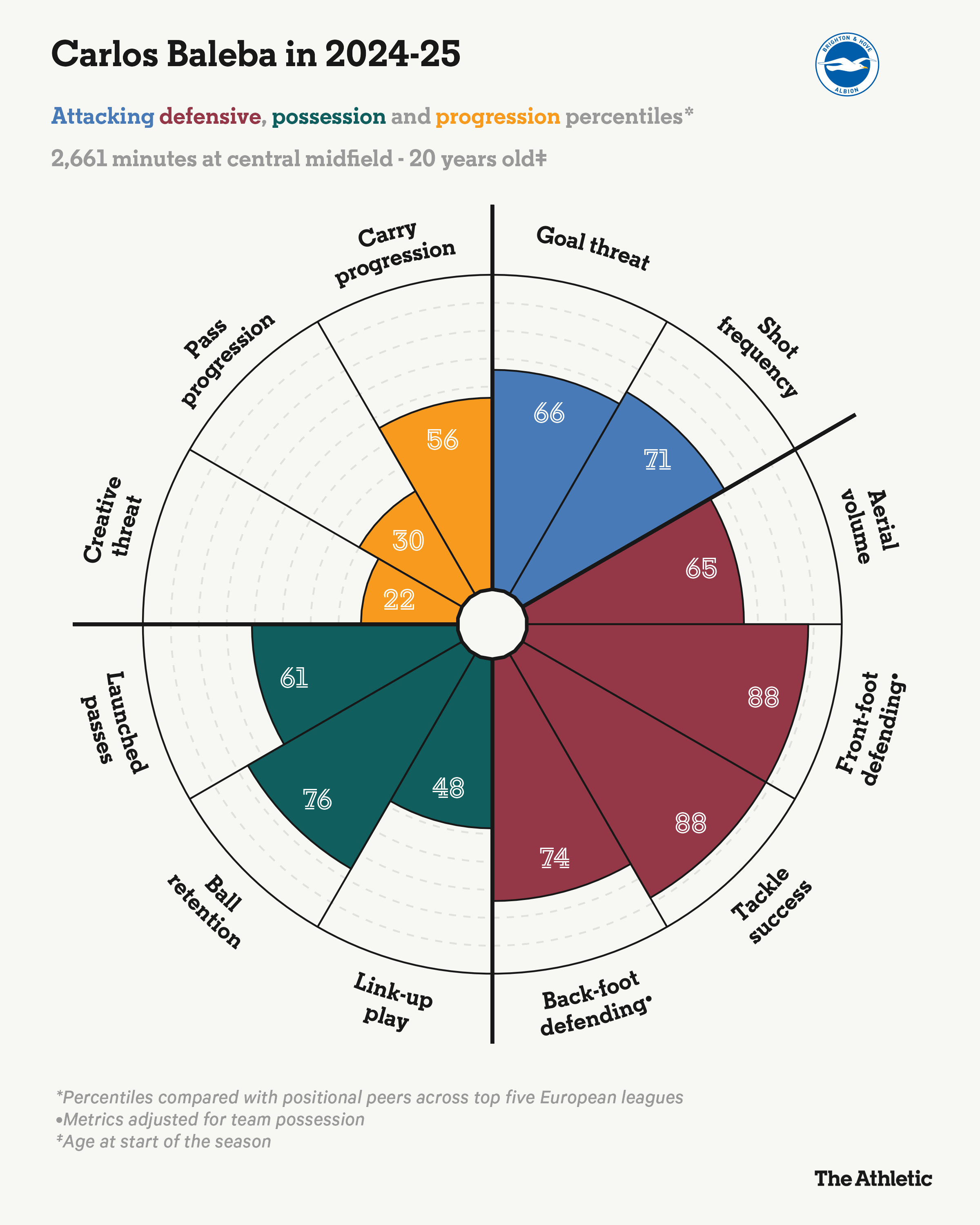
Not only is he high-volume in those actions (Front-foot defending, 88 out of 99), but he will come out of his challenges on top more often than not (Tackle success, 88 out of 99). Catching opponents on the blindside and snatching the ball away from them is a skill Baleba has honed very well in the past 18 months.
Add Baleba’s rarity as a left-footed central midfielder and there are few players with his profile in the market.
According to SkillCorner, Baleba’s ability to retain possession under pressure was among the best in Europe’s top five leagues when compared with fellow under-23 midfielders, highlighting just how mature he is in looking after the ball in central areas.
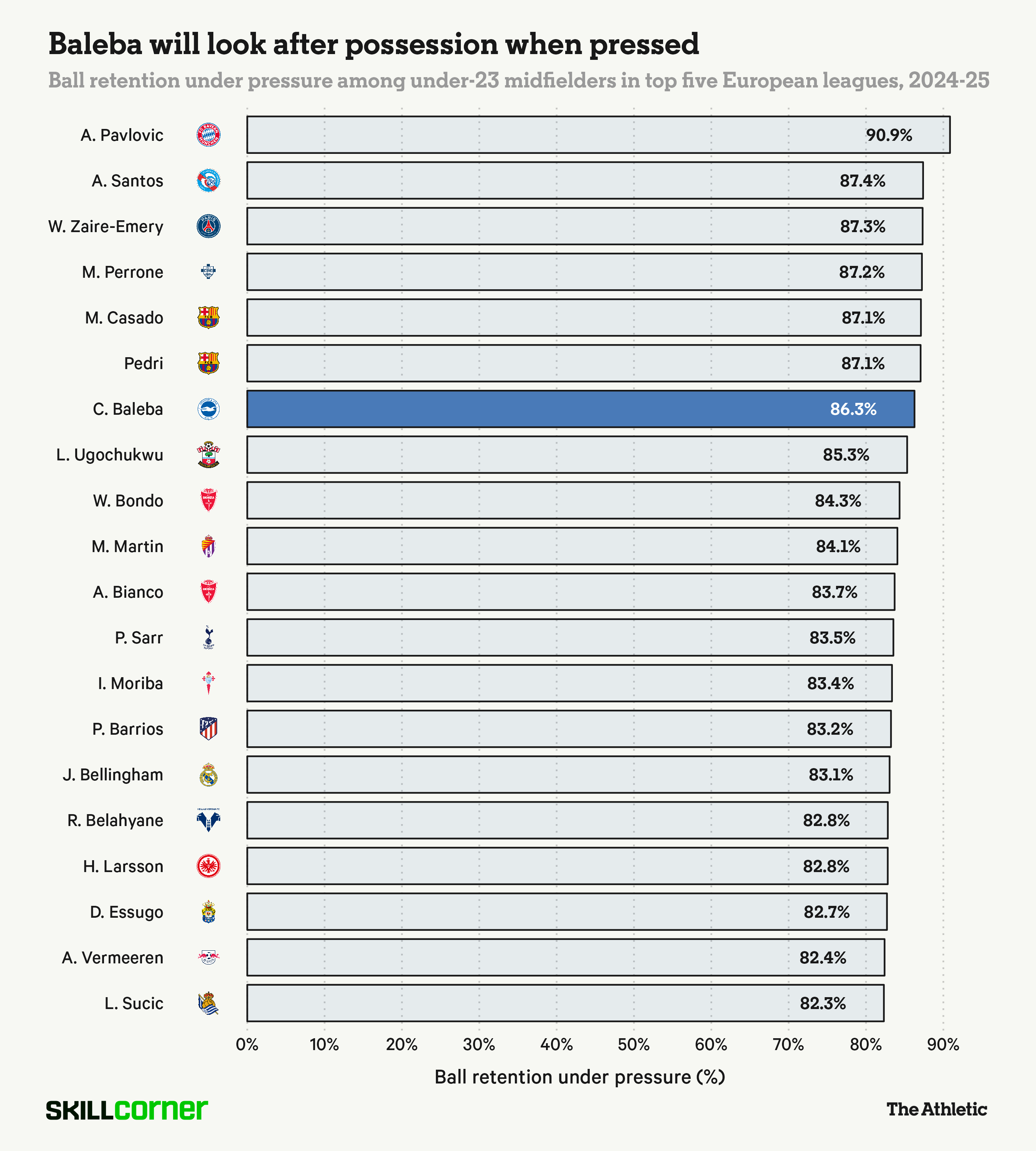
Given his athleticism, Baleba’s ability to wriggle out of trouble by moving dynamically with the ball at his feet is widely known among the Brighton fanbase, with a driving run that can move his side from deeper build-up areas to the middle third in a single breath.
Mark Carey and Liam Tharme
What else we’re hearing
- Liverpool are interested in Parma centre-back Giovanni Leoni. They are trying to persuade the defender to move to Anfield this summer, but accept that convincing him to leave Italy will be highly challenging. No clubs in Italy can afford him at this moment in time, with Milan going for Genoa’s Koni De Winter as a result. The 18-year-old is highly rated and played 17 games for Parma in Serie A last season. Leoni has been capped seven times at Under-19 level by Italy. David Ornstein, James Horncastle and James Pearce
- Gianluigi Donnarumma is willing to leave Paris Saint-Germain — but only for the right club and at the right moment. The goalkeeper is in the final year of his contract, and sources close to the player have indicated they expect him to leave. PSG sources seem accepting of the idea of losing him and say they offered the goalkeeper a new contract on improved terms, but this was turned down. But he will not be forced out or made to accept an offer that he does not want. James Horncastle and Mario Cortegana
- Everton have agreed a deal to take Jack Grealish on loan from Manchester City. The deal still needs to be finalised but a medical was scheduled for Monday for the England international. An option to buy in the region of £50milllion will be included. David Ornstein and Gregg Evans
- Chelsea forward Christopher Nkunku would be open to a return to RB Leipzig this summer if his former club’s interest in a potential move advances. Nkunku has been the subject of enquiries from clubs in Germany, England and Italy this summer. Leipzig are among a number of sides interested in the 27-year-old, but have some financial reservations about the logistics of a potential deal given their need to keep their wage bill lower this season, having failed to secure European football for the 2025-26 campaign. Sebastian Stafford-Bloor
- Al Nassr have reached an agreement in principle with Bayern Munich for Kingsley Coman. The deal for the winger is set to be between €25m and €30m. Coman will be Al Nassr’s fifth permanent transfer of the summer, most recently securing the signing of centre-back Inigo Martinez from Barcelona for no fee. Meanwhile, Bayern have signed winger Luis Diaz from Liverpool on a €75million (£65.6m; $88.1m) deal. Sebastian Stafford-Bloor
- Nottingham Forest are close to a deal for Manchester City midfielder James McAtee. Nothing has been agreed at this stage but talks are moving in a positive direction. McAtee, 22, is available on a permanent transfer this summer and The Athletic reported in the DealSheet in July that he had attracted interest from England and Germany, with Forest among his admirers. Paul Taylor
- Newcastle United are advancing in negotiations to loan Odysseas Vlachodimos to Sevilla for the 2025-26 campaign. The 31-year-old goalkeeper joined for £20million from Nottingham Forest last summer, with Elliot Anderson moving in the opposite direction. Those deals came about due to Newcastle United’s desperate need to comply with the Premier League’s profit and sustainability rules (PSR) by June 30, 2024. Vlachodimos was not initially a target for Newcastle back then and does not feature in Eddie Howe’s plans, having made a solitary substitute appearance against AFC Wimbledon in the Carabao Cup across 2024-25. Sevilla are looking to take Vlachodimos on a straight loan for the season, which does not contain an option or clause for the Spanish side to buy the Greece international, and Newcastle are set to pay the majority of his wages. Chris Waugh and Mario Cortegana
How much has each Premier League club spent so far this season?
Manchester United’s signing of Benjamin Sesko over the weekend took their spend on transfer fees to just shy of £200m this summer and also elevated them as the highest spending Premier League club on a net basis. United have spent heavily on Sesko, Bryan Mbeumo and Matheus Cunha without yet recouping a transfer fee in return; only Arsenal’s £185.7m net spend comes close to that dispensed at Old Trafford so far this window.
For all the talk of Liverpool spending heavily — and they remain the highest spenders on a gross basis — five clubs have spent more on a net basis than their £83.6m, per Transfermarkt. That cohort of five includes Sunderland, whose own summer splurging shows little sign of abating. They’re expecting to complete the signing of Getafe centre-back Omar Alderete soon.
Liverpool have offset their spending on new faces by selling well, with Darwin Nunez’s departure for Saudi Arabia the latest example. The Anfield outfit have recouped nearly £170m in transfer fees this summer, a figure only usurped by perennial good sellers Chelsea. The latter are estimated to have now tipped over the £200m figure in sales, on the back of the departures of Lesley Ugochukwu and Armando Broja to newly promoted Burnley.
In turn, that put Burnley over the £100m barrier for new signings, making them one of eight Premier League clubs to hit nine-figures when it comes to transfer spending in the last couple of months.
At the other end of the scale, neither Crystal Palace nor Fulham are yet to spend much of anything, though nor have they been active sellers. Interestingly, the lowest spenders on a net basis are all clubs who competed to break into the top eight last season: Brighton & Hove Albion, Brentford, Nottingham Forest and Bournemouth have all taken in much more than they’ve spent so far this summer.
Chris Weatherspoon
Arsenal
What happened this week?
Arsenal announced a new five-year contract for Ethan Nwaneri. Securing Nwaneri’s future is excellent news for the club. Nwaneri had fielded interest from elsewhere in the Premier League and abroad, but his preference was always to find an agreement with Arsenal.
Other than that, it has been relatively quiet: with the bulk of Arsenal’s incoming transfer business done, the focus has been on preparing the current players for the start of the new season.
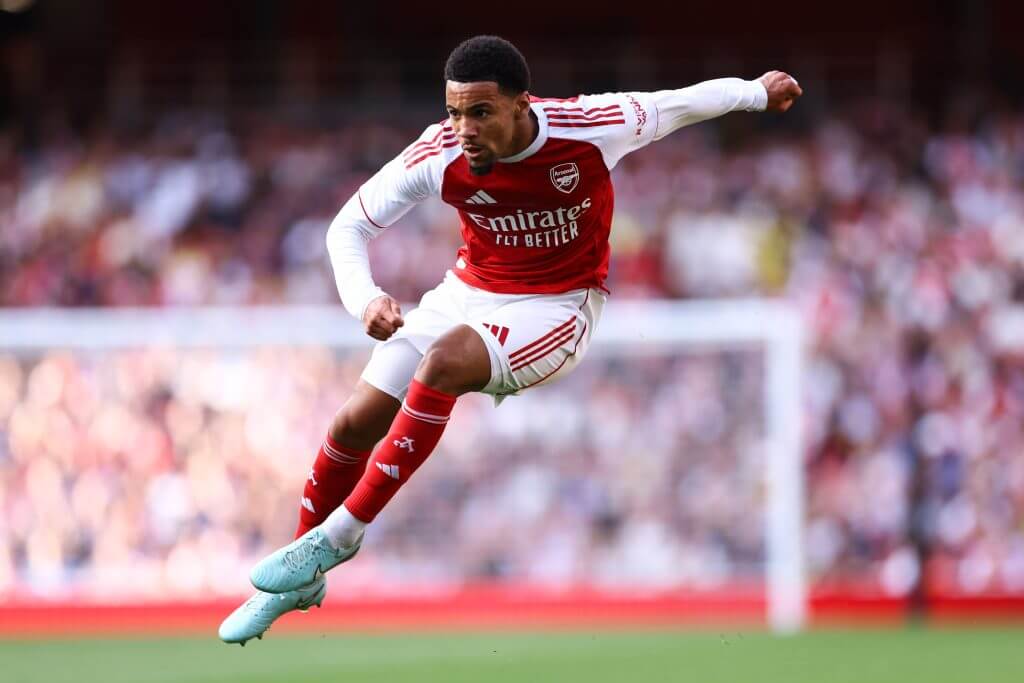
Nwaneri has signed a new contract with Arsenal (Jacques Feeney/Offside/Offside via Getty Images)
It’s under a week to the new season — do Arsenal look ready?
They had their best performance of pre-season against Athletic Club, running out 3-0 winners thanks to goals from Viktor Gyokeres, Bukayo Saka and Kai Havertz.
It was an encouraging display, with familiar defensive solidity coupled with dynamic attacking. Gabriel, Riccardo Calafiori, Jurrien Timber and Havertz are also fit again, just in time for the new season.
What positions/players are they still looking at?
Asked after the win over Athletic whether Arsenal will add to the six signings they have already made, manager Mikel Arteta said: “Let’s see what happens in terms of where the squad is in the next few weeks, but we are actively looking at options.
“There are a few players that have to leave as well, so we’ll be open to see what happens.”
If Arsenal are to make another addition, it is likely to be in the attacking part of the pitch. Arsenal have been studying candidates to improve their left-wing options, but ideally, the club would like to make some sales before prioritising another arrival.
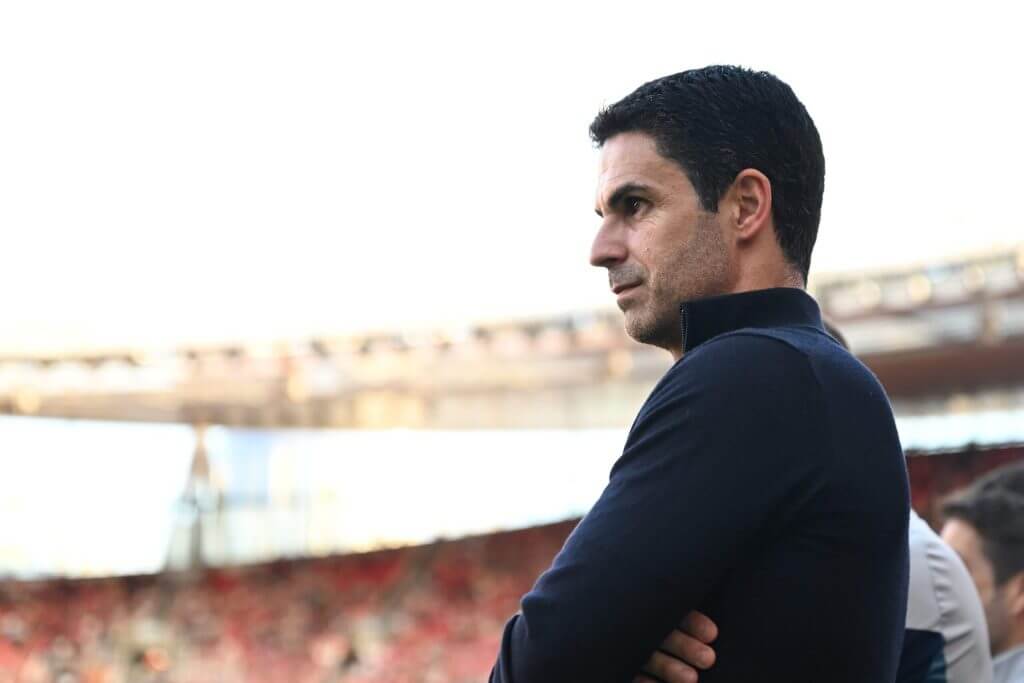
Arteta said Arsenal are looking at options (Stuart MacFarlane/Arsenal FC via Getty Images)
Which players could be leaving?
Several players who spent last season out on loan — Fabio Vieira, Karl Hein, Albert Sambi Lokonga and Reiss Nelson — are available to leave the club before the transfer deadline on September 1. Vieira is the subject of talks between Arsenal and Stuttgart, while Fulham have held negotiations over Nelson’s return. In both cases, Arsenal favour a permanent deal.
Oleksandr Zinchenko is also available to leave before the deadline, although the Ukraine international is considering seeing out the final year of his Arsenal contract and moving on a free transfer in 2026. Arsenal, naturally, would prefer a sale in this window.
Polish international Jakub Kiwior is open to leaving for a club where he can be a regular starter. Arsenal are in no rush to sell, however, and none of the clubs tracking Kiwior have yet met their asking price.
James McNicholas
Chelsea
What happened this week?
Chelsea’s steady stream of outgoings gathered pace. Marc Guiu completed a season-long loan move to Sunderland, while Everton signed Kiernan Dewsbury-Hall for £25m.
Burnley also finalised the purchases of two unwanted Chelsea players in midfielder Ugochukwu and home-grown striker Broja, raising significant funds.
Chelsea stepped up talks to prise out-of-favour Manchester United winger Alejandro Garnacho from Old Trafford.
On the pitch, Chelsea won both of their pre-season friendlies impressively against Bayer Leverkusen and Milan. The optimistic glow around Stamford Bridge was dimmed a little by the news that defender Levi Colwill tore his ACL in training at Cobham and is expected to miss most of the season after undergoing surgery.
Nicolas Jackson was also left out of Enzo Maresca’s squad for both matches as Chelsea and the striker explore a possible transfer in the final weeks of the summer window.
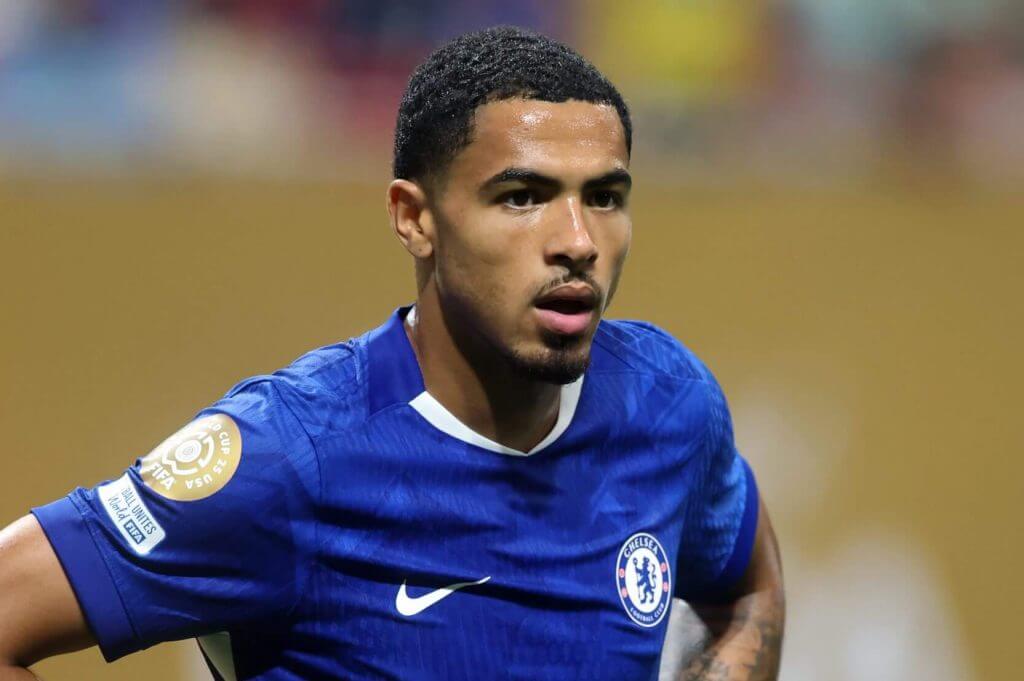
Colwill has torn his ACL (Alex Grimm/Getty Images)
Does signing a Colwill alternative now feel crucial?
Colwill was fundamental to Chelsea’s biggest achievements last season, playing twice as many minutes as any of Maresca’s other centre-backs. His influence was huge both in and out of possession, so losing him to such a serious injury on the eve of the new season is a real blow to their aspirations.
But there is no sense of panic at Stamford Bridge, and Chelsea feel no urgent need to delve into the summer transfer market to replace him.
This is precisely why you amass the level of depth that they have over the last two-and-a-half years; even with Colwill sidelined, Chelsea still have as many as 10 senior players competing for four defensive positions. Maresca trusts Trevoh Chalobah and Tosin Adarabioyo, and Wesley Fofana is nearing a return to full fitness. Summer signing Jorrel Hato is equally capable of playing at centre-back or left-back.
Benoit Badiashile was regarded as a close to equivalent talent to Colwill, with a very similar profile, when he was acquired from Monaco in January 2023. Josh Acheampong won the love of Maresca in last season’s Conference League campaign and looks ready to shoulder greater responsibility.
Then there is Aaron Anselmino, who specialised in playing as the middle of three defenders in possession at Boca Juniors and could be kept around this season if Maresca deems him ready.
Chelsea are confident in their alternative options, and Colwill’s unfortunate injury could prove exactly the kind of opportunity that one of his team-mates has been waiting for.
What positions/players are they still looking at?
Chelsea would still like to sign a winger and an attacking midfielder before the transfer window closes, and the names at the top of their wish list for each position are well known.
Garnacho is the top choice for a right-footed left winger to compete with summer signing Jamie Gittens. Chelsea have stepped up talks in the wake of the Sesko deal and view the Argentine’s situation at Old Trafford as an opportunity, but they are not inclined to simply meet Manchester United’s valuation of the player.
As detailed by my colleague David Ornstein last week, Garnacho expects to join Chelsea and has ruled out all options other than moving to Stamford Bridge or staying at Old Trafford.
Another ongoing situation is that of Xavi Simons. Informal discussions have been held with Leipzig over a move for the Netherlands international, but no formal bid has been made. Chelsea also like Aston Villa’s Morgan Rogers as a potential fit for the attacking-midfield role.
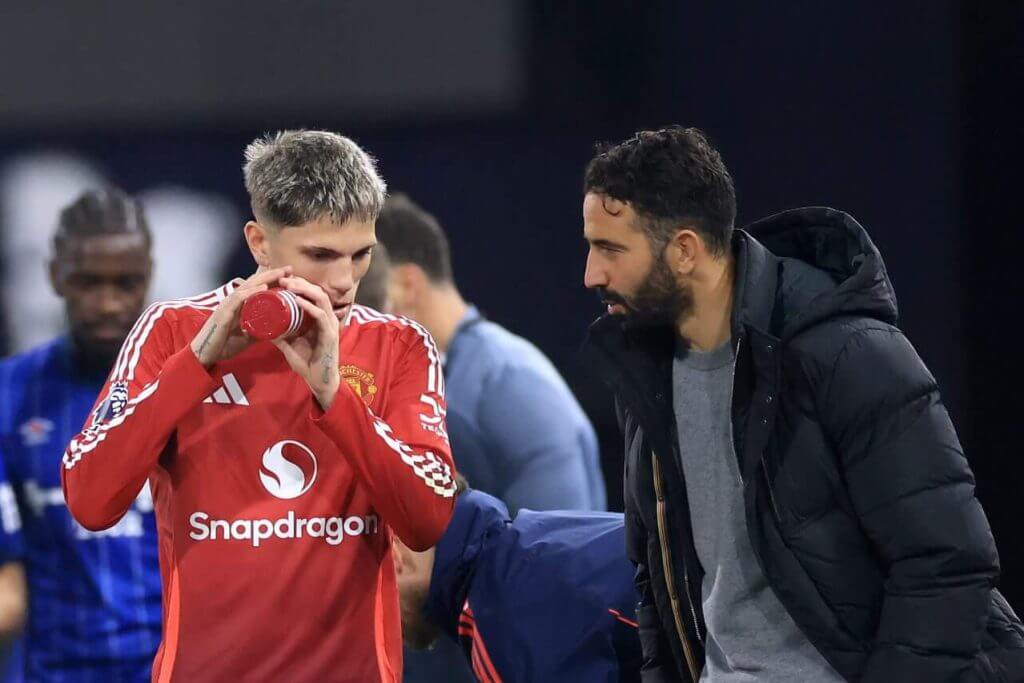
Chelsea have stepped up talks for Garnacho (Stephen Pond/Getty Images)
Which players could be leaving?
Substantial progress has been made in trimming Chelsea’s player list, but there is more work to be done in the remainder of August.
Jackson and Christopher Nkunku were left out of Chelsea’s pre-season friendlies against Leverkusen and Milan as they, their representatives and the club explore potential moves away.
Senior sources at Stamford Bridge say that Jackson will be reintegrated into Maresca’s squad after the deadline if no transfer materialises. Chelsea are not desperate to sell him but recognise that he may want to be the lead striker at another club, and are open to sanctioning a sale if the proposal satisfies all parties.
There is more confidence that Nkunku will depart; he is open to a return to Leipzig but is commanding interest from other Bundesliga sides as well as clubs in Italy and the Premier League.
At the other end of the pitch, Renato Veiga will not return to Chelsea’s first team squad despite Colwill’s injury and is expected to be sold for a substantial profit this summer.
Garnacho’s arrival would further limit Tyrique George’s game time, and Chelsea will work with him and his representatives to find a club where he can play more regularly this season. That could be a loan or even a permanent sale if the proposal is right. A number of clubs in England and in Europe have expressed interest.
Chelsea are still working on the departures of Raheem Sterling, Ben Chilwell, Carney Chukwuemeka and Axel Disasi. Alfie Gilchrist is expected to be sold to a Championship club before the transfer deadline on September 1.
Liam Twomey
Liverpool
What happened this week?
Liverpool completed the sale of striker Darwin Nunez to Saudi Pro League side Al Hilal for an initial fee of €53m. It brought to an end the erratic Uruguayan’s three-year stay at Anfield. The Premier League champions believe that once achievable add-ons are triggered, the deal will ultimately be worth around €65m.
Young midfielder Tyler Morton joined French club Lyon in a €15m deal with Liverpool negotiating a 20 per cent sell-on clause.
Senior Anfield figures dismissed reports that Liverpool were targeting PSG attacker Bradley Barcola. Liverpool believe bringing in a left-sided attacker with his profile would block the pathway for talented teenager Rio Ngumoha, who is now viewed as part of Arne Slot’s senior squad after an impressive pre-season.
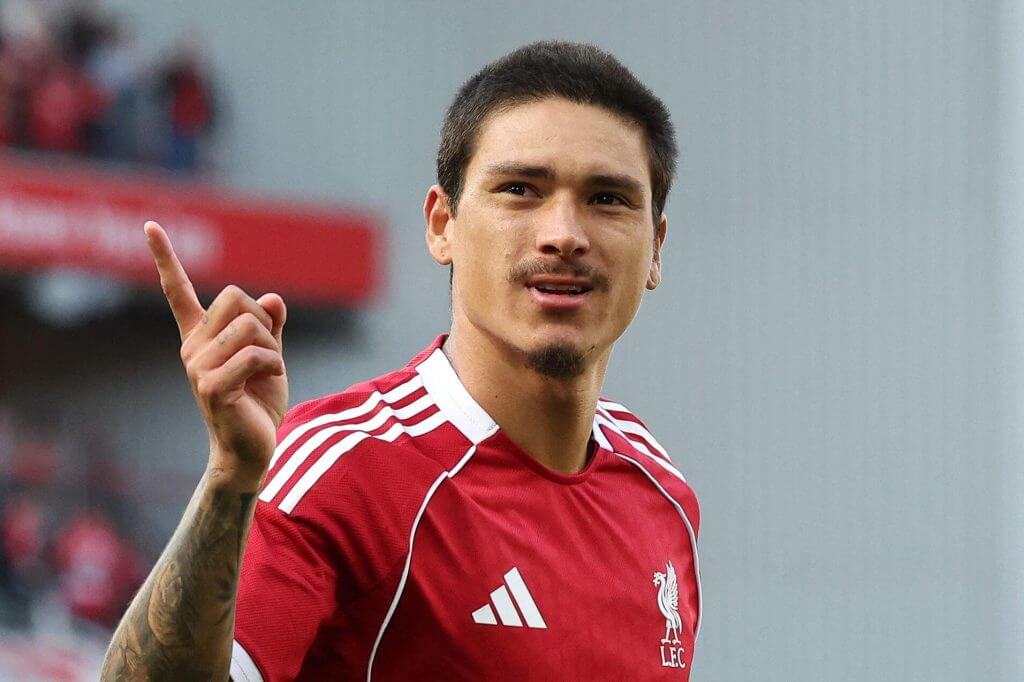
Liverpool have sold Nunez to Al Hilal (Darren Staples/AFP via Getty Images)
Does Nunez’s exit free up funds for Isak?
Liverpool had already bid £110m for Isak before selling Nunez, so it’s not as if they have been relying on further outgoings to make their move for the Swedish striker.
However, it certainly opens up a space in the squad and gives them more leeway financially. For all the talk about Liverpool’s £300m spending spree so far this summer, sporting director Richard Hughes has also generated around £200m from sales when you include performance-related add-ons.
Liverpool have the capacity to shatter the British transfer record for Isak without any concerns over PSR. But so far, there’s no sign of Newcastle’s ‘not for sale’ stance shifting. That’s the reason why Liverpool have yet to table an improved bid for Isak.
What positions/players are they still looking at?
As well as a centre-forward, Liverpool are also in the market for a centre-back, having yet to replace Jarell Quansah, who was sold to Bayer Leverkusen last month.
With Joe Gomez out with an Achilles injury, Slot only has two recognised senior centre-backs in Virgil van Dijk and Ibrahima Konate ahead of Friday’s Premier League opener at home to Bournemouth.
Young Parma centre-back Giovanni Leoni is highly-regarded. Liverpool have also previously shown interest in Crystal Palace skipper Marc Guehi, who is down to the final year of his contract.
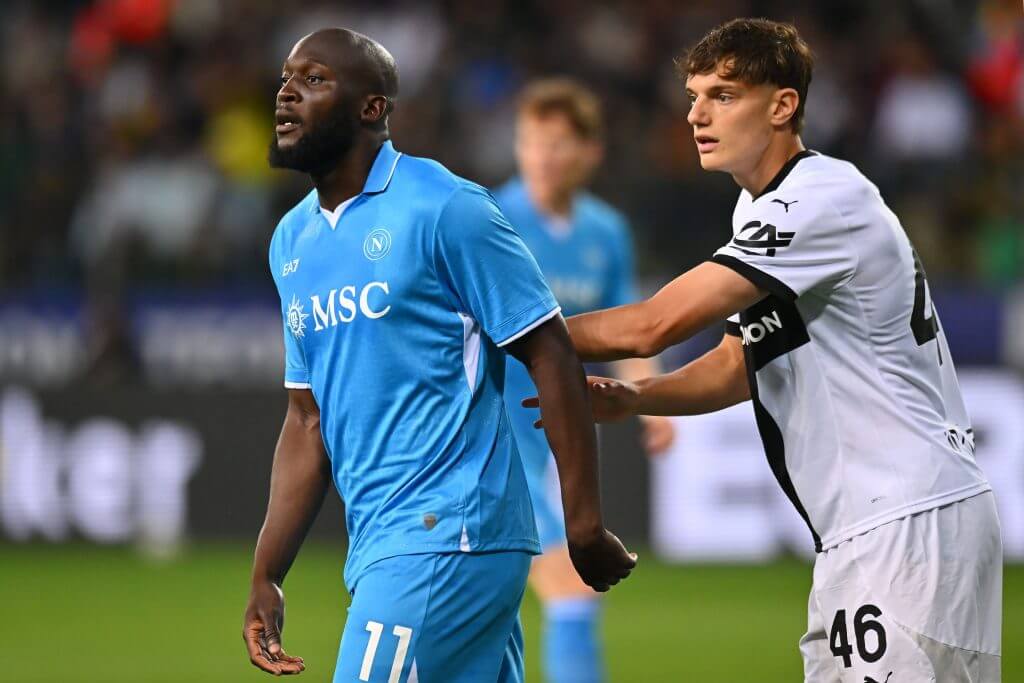
Liverpool regard Leoni highly (Alessandro Sabattini/Getty Images)
Which players could be leaving?
Harvey Elliott has been attracting interest from Bundesliga outfit Leipzig, who view him as a potential replacement for Xavi Simons. Liverpool value Elliott at around £50m.
Kostas Tsimikas was left out of Slot’s squad for Sunday’s Community Shield. Liverpool are open to sanctioning a permanent exit for the Greece international. Nottingham Forest are among the clubs to have shown interest.
The future of young winger Ben Doak is also unclear. Newly promoted Leeds United are one of several top-flight clubs keen on Doak, who is valued at around £20m.
Luca Stephenson is set to sign a new deal at Anfield and then head to Dundee United on a season-long loan.
James Pearce
Manchester United
What happened this week?
United sealed the transfer of Sesko, agreeing a fee with Leipzig of €76.5m plus €8.5m in add-ons. Sesko flew in on Thursday, completed his medical on Friday, signed his paperwork on Saturday and was presented to United fans on the pitch at Old Trafford ahead of the Fiorentina game.
Rasmus Hojlund was left as an unused substitute for United’s final pre-season friendly, with Mason Mount preferred up front instead. Afterwards, Ruben Amorim said: “In some moments, I felt that we struggled without a reference as a striker. We have a new player, so we’ll see.”
Amorim declining to use Hojlund in the match, then neglecting to mention him afterwards, is a sign of the club’s intentions to sell him.
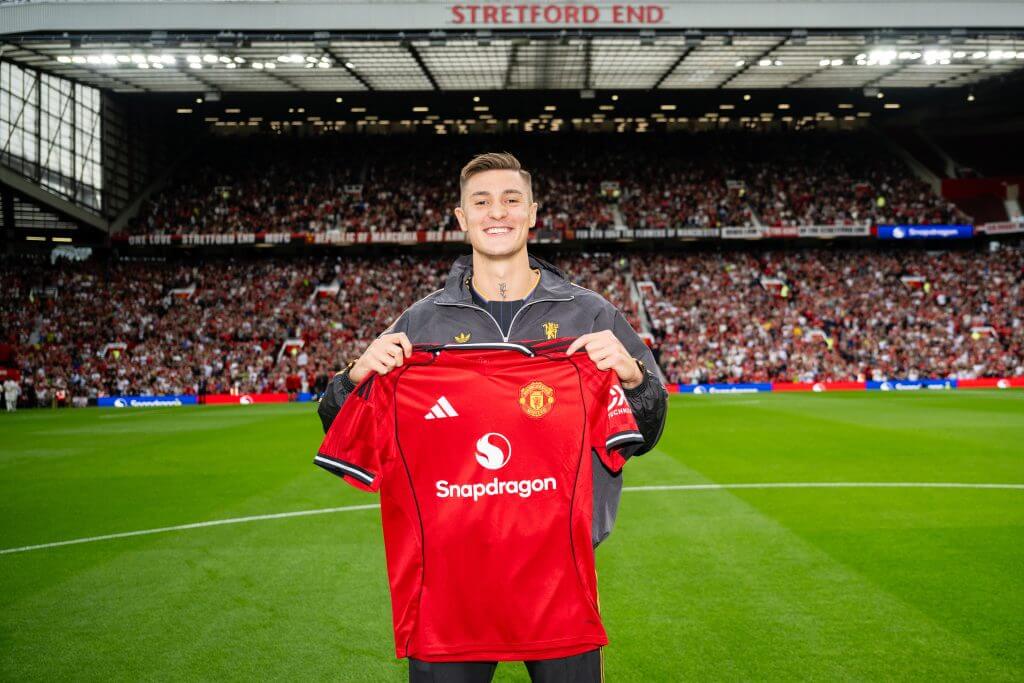
Sesko was presented to the United fans on Saturday (Ash Donelon/Manchester United via Getty Images)
With Sesko in, will transfer business slow down?
That would be the logical assessment. But United are taking a bold approach to this window, the first under INEOS rule when the structure is established above a head coach of their choosing. Activity might even speed up.
Amorim’s desire to reshape his squad is clear, which is why United are exploring an ambitious move for Carlos Baleba. Talks continue on Brighton’s willingness, or not, to entertain a sale. Amorim wants a dynamic No 6, who can stop attacks and link defence with the frontline.
Going the other way, bringing in money for Garnacho is a priority, and progress is being made on talks with Chelsea. Clubs are taking a look at Hojlund, who at present insists he wants to stay and fight for his place.
What positions/players are they still looking at?
United remain in the market for a midfielder, with the pursuit of Baleba explained above. Sir Jim Ratcliffe wants United to be capable of making a major impression this campaign, and signing a player of Baleba’s quality would be expected to significantly aid those aims.
The goalkeeper position carries some intrigue, with United continuing to be linked with a new No 1. Donnarumma is the latest name, and he appears to be heading for the exit at PSG after they signed Lille goalkeeper Lucas Chevalier.
At 23, Chevalier is three years younger than Donnarumma, who has not agreed to a new contract. His current terms expire in 2026. United’s stance on goalkeepers — since Aston Villa rejected their loan offer for Emiliano Martinez — is that a signing could only happen if Andre Onana departs, and there are no signs of that at present.
Onana is hoping to be fit for the opening game of the Premier League against Arsenal on Sunday. A move for Donnarumma is not expected to materialise.
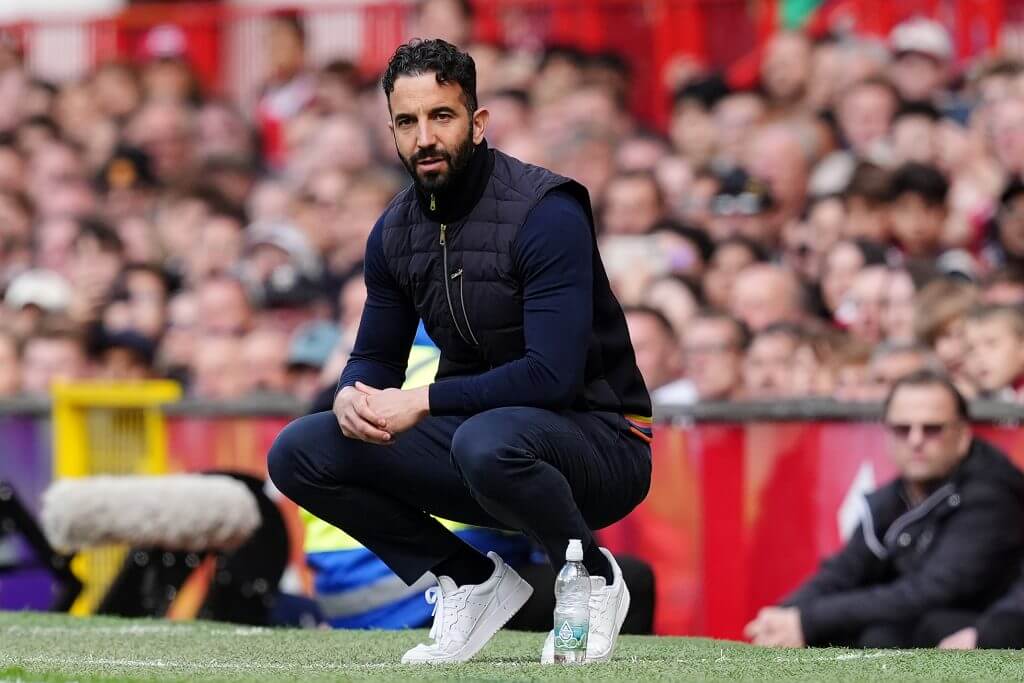
Amorim is in his first summer as Manchester United manager (Martin Rickett/PA Images via Getty Images)
Which players could be leaving?
As well as Garnacho and Hojlund, Antony, Jadon Sancho and Tyrell Malacia.
Harry Amass, who was left out of United’s tour to the U.S. is attracting loan interest from several clubs from the Championship and Europe, with around 15 suitors in touch. Game time will be the main factor in selecting his club.
Laurie Whitwell
Newcastle United
What happened this week?
You mean aside from Eddie Howe fielding an inordinate number of questions about Alexander Isak’s future? (Apologies, but there will be more on Isak later.)
Well, Sesko has become the latest player to turn down Newcastle in favour of a move elsewhere — an eventuality some inside St James’ Park had feared from the start of that ambitious pursuit — while long-serving goalkeeper Martin Dubravka has joined Burnley permanently.
Malick Thiaw, meanwhile, is close to being unveiled as the third senior signing of the summer, after Anthony Elanga and Aaron Ramsdale.
The 24-year-old Germany international centre-back underwent his medical on Monday, having flown to Tyneside on Sunday evening, and will join from Milan for an upfront fee of €35m alongside €5m in add-ons. Thiaw has been a long-term target, with Howe confirming that the defender was a player he admired during the summer of 2024, and his arrival means that Newcastle have finally reinforced at right-sided centre-back, something they have been aiming to do for three years.
Elsewhere, on the striker front, Newcastle remain in protracted talks to sign Yoane Wissa from Brentford, though substantive progress has yet to be made, while Porto’s Samu Aghehowa is among the alternative centre-forwards the club have discussed internally.
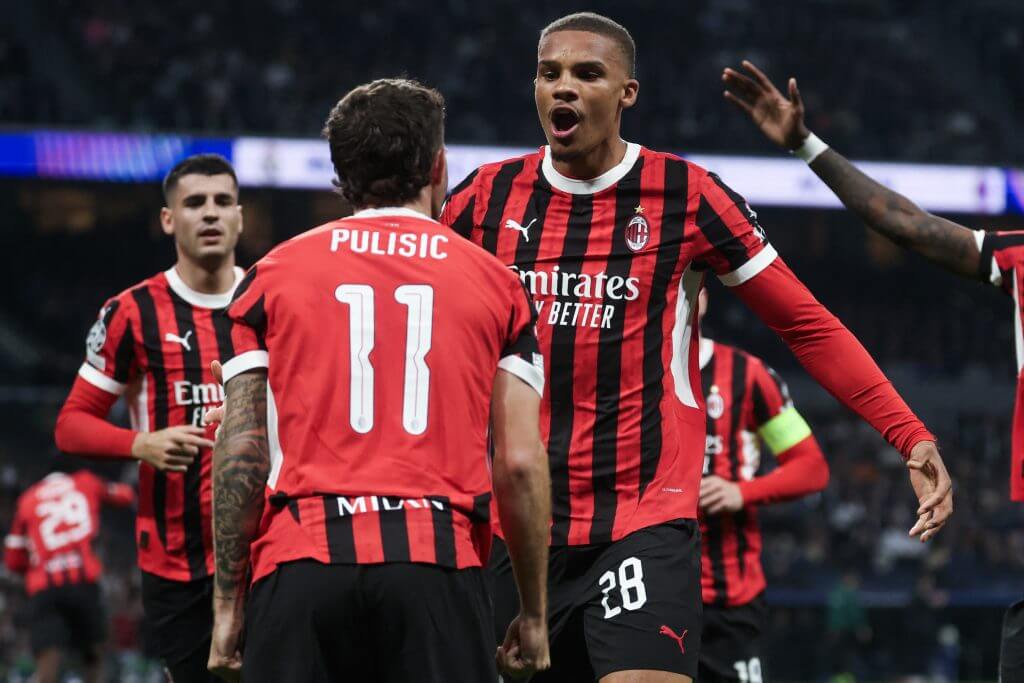
Thiaw is on the cusp of joining Newcastle (Pierre-Philippe Marcou/AFP via Getty Images)
What is the priority with a week to go until the season?
Somewhat perversely, despite the cloud of negativity which has understandably loomed over Newcastle’s summer, their window may yet end with the squad being significantly strengthened in all the areas the club hoped to.
That remains a big if for now, however, given that goals are a massive concern and Isak was missing in action throughout the whole of Newcastle’s (winless) pre-season friendly campaign. My colleague David Ornstein explained further on Isak’s future above, and the striker’s perspective, but it is clear that reintegrating him would be a huge task.
Howe admitted on Friday that it is “clear I can’t involve” Isak at the moment, while insisting that the striker “has a future” at St James’. The head coach has managed the situation delicately, stressing that he can only work with players who “want” to play for the club, and at the same time refusing to overtly criticise Isak.
Liverpool have yet to return since seeing a £110m bid rejected at the start of this month, and Newcastle remain adamant, from the boardroom down, that Isak is not for sale. That message, which continues to be repeated, is only likely to soften if Newcastle sign two strikers and Liverpool offer a fee close to £150m.
As things stand, those two eventualities appear unlikely, which means the priority has to be on bringing in a replacement for Callum Wilson. Howe will also be hoping that he can use all of his man-management skills to coax Isak back around so that the Sweden international leads the line for the majority of the 2025-26 season, even if he is set to miss the start of the campaign. Whether or not that is possible remains to be seen.
Wissa would be the ideal replacement for Wilson, but Brentford will not sell until they sign a replacement and, even then, Newcastle have to agree a fee and will not overpay for a player who turns 29 next month. While Aghehowa has been watched and is liked, he is only 21, and a deal would be complicated and expensive. Wolverhampton Wanderers’ Jorgen Strand Larsen has also been considered, though his club do not deem the striker to be for sale.
Newcastle are actively pursuing alternatives in case the Wissa deal does not happen, though they are running out of time, and so Anthony Gordon is set to lead the line as a makeshift centre-forward against Aston Villa on Saturday.
What positions/players are they still looking at?
Beyond centre-forward, which is clearly their most pressing need, Howe ideally wants to sign another midfielder following Sean Longstaff’s departure to Leeds United last month. Joe Willock is also suffering from a calf injury, which is set to keep him out for another month.
Although Howe has an elite first-choice midfield of Joelinton, Sandro Tonali and Bruno Guimaraes, and an exciting prospect as back-up in Lewis Miley, alongside Willock, the head coach likes to operate with six options, given he usually starts with three of them. Considering the additional demands of Champions League football, another midfielder is required.
Ideally, an attacking midfielder in the No 8 mould would arrive. West Ham United’s Lucas Paqueta is unlikely to be that addition, despite being linked, with Newcastle focusing on options elsewhere. As mentioned by David Ornstein, Newcastle are emerging as Jacob Ramsey’s preferred destination.
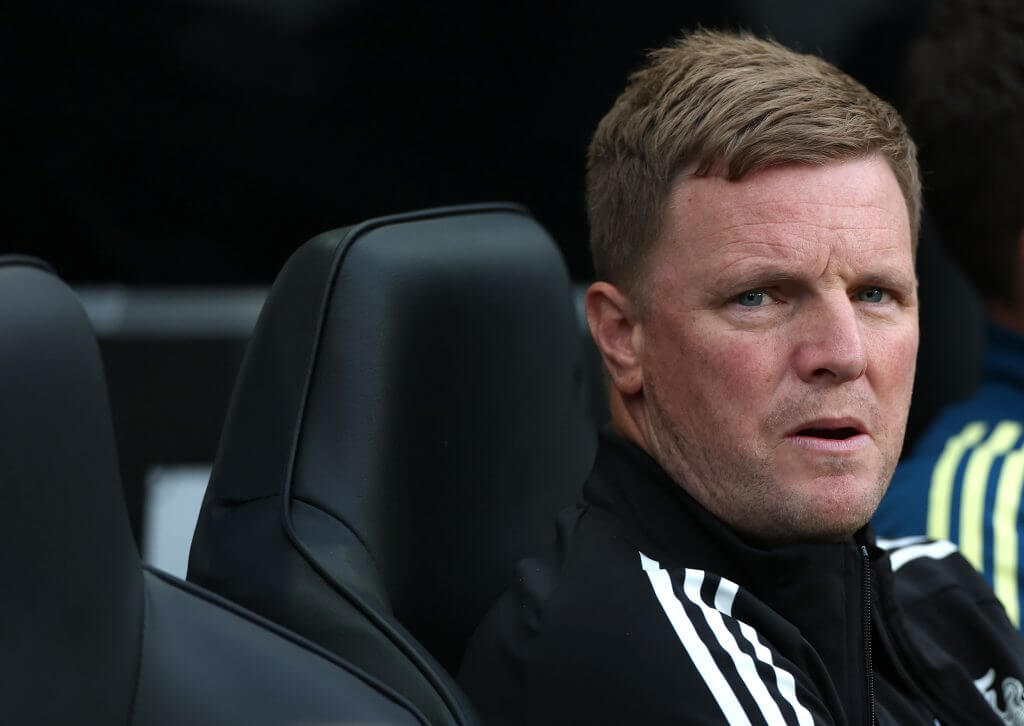
Howe’s system means another midfielder is needed (Stu Forster/Getty Images)
Which players could be leaving?
There’s a player whose name begins with “I” who you may have heard wants to leave, though Newcastle remain steadfast that Isak can and will be reintegrated, rather than join Liverpool.
Elsewhere, as The Athletic reported on Monday, Odysseas Vlachodimos is set to join Sevilla on a season-long loan. The Greece international made only one substitute appearance last season, and Newcastle are due to cover the majority of his wages. The framework of the deal being discussed does not include an option or obligation to buy and is just a straight loan.
Newcastle would not stand in the way of full-backs Matt Targett or Harrison Ashby leaving.
As Isak’s situation shows, Newcastle cannot take anything for granted, but they are determined to hold on to their other prize assets, Tonali, Guimaraes, Gordon and Tino Livramento.
Chris Waugh
Tottenham Hotspur
What happened this week?
There were two big developments at Tottenham last week, both of them largely known in advance from the end of the Asia tour.
First, Son Heung-min’s departure was confirmed to LAFC in MLS after 10 years at Tottenham. He said some emotional goodbyes to the Spurs fans and is now already playing for his new club.
Second, the club confirmed the news that James Maddison ruptured his ACL and would need knee surgery. Beyond that, there have been no more arrivals since Joao Palhinha’s loan from Bayern Munich was announced.
There have been other departures, specifically of young players going out on loan: Alfie Devine to Preston North End, Portsmouth for Yang Min-hyeok, Oxford United for Will Lankshear, Stoke City for Jamie Donley, Wycombe Wanderers for George Abbott and Notts County for Tyrese Hall.
Mikey Moore, who is on loan at Rangers, also signed a new long-term contract.
Spurs travelled to Bayern Munich for a pre-season friendly on Thursday and lost 4-0.
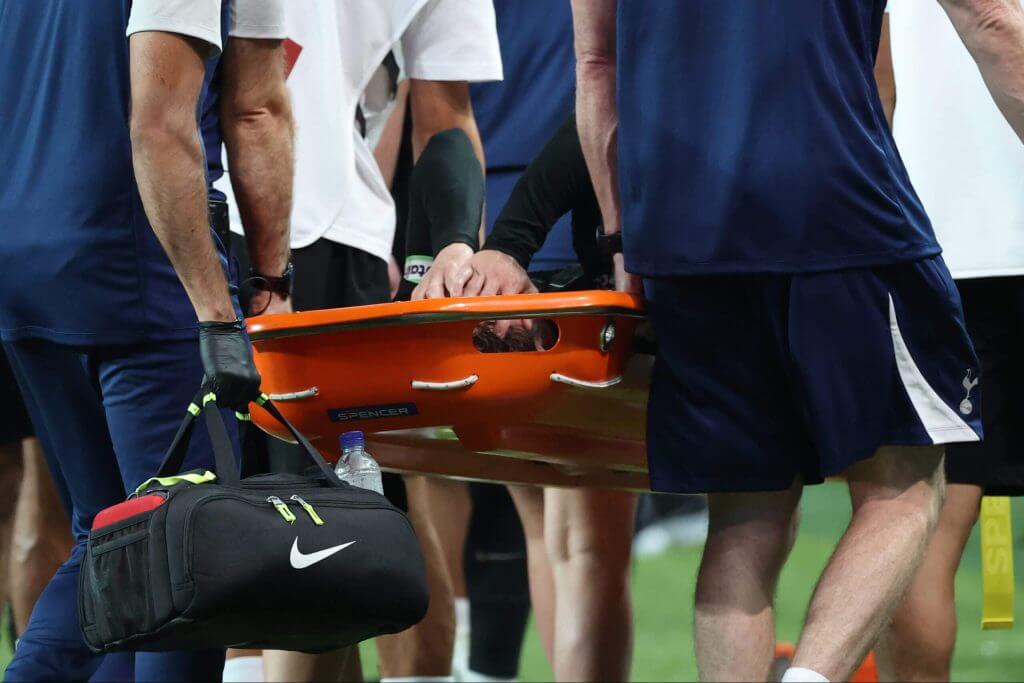
Maddison is set for a long spell on the sidelines (Chung Sung-Jun/Getty Images)
Is replacing Maddison now the priority?
Thomas Frank admitted in Munich last week that yes, Tottenham will be looking for players who can cover for Maddison following his knee injury. “We are definitely in the market in general,” Frank said. “Of course, when players get a long-term injury, we need to look into that.”
Maddison will miss much of this season after knee surgery, while Dejan Kulusevski, who had knee surgery of his own in May, will also miss the start of the season. “Out for a long time” is how Frank put it.
So Tottenham clearly need creative quality in attacking midfield before the start of the season. They have plenty of solidity in the middle of the pitch, especially after adding Palhinha this window.
And they have plenty of pace in wide areas now, even more so after signing Mohammed Kudus from West Ham at the start of the window. But creativity in the No 10 role is the glaring issue with the squad.
What positions/players are they still looking at?
Attacking quality is the main focus at Spurs right now.
The Athletic reported on Monday morning that Spurs have approached Manchester City about signing Brazilian winger Savinho, discussing a package of roughly €50m for his signing. City, however, said that they do not want to sell Savinho and regard the matter as closed.
Tottenham are also big admirers of Nico Paz, the 20-year-old Argentina international currently at Como in Serie A. Como do not want to sell Paz either, and Real Madrid have the right to match any bid for Paz this summer.
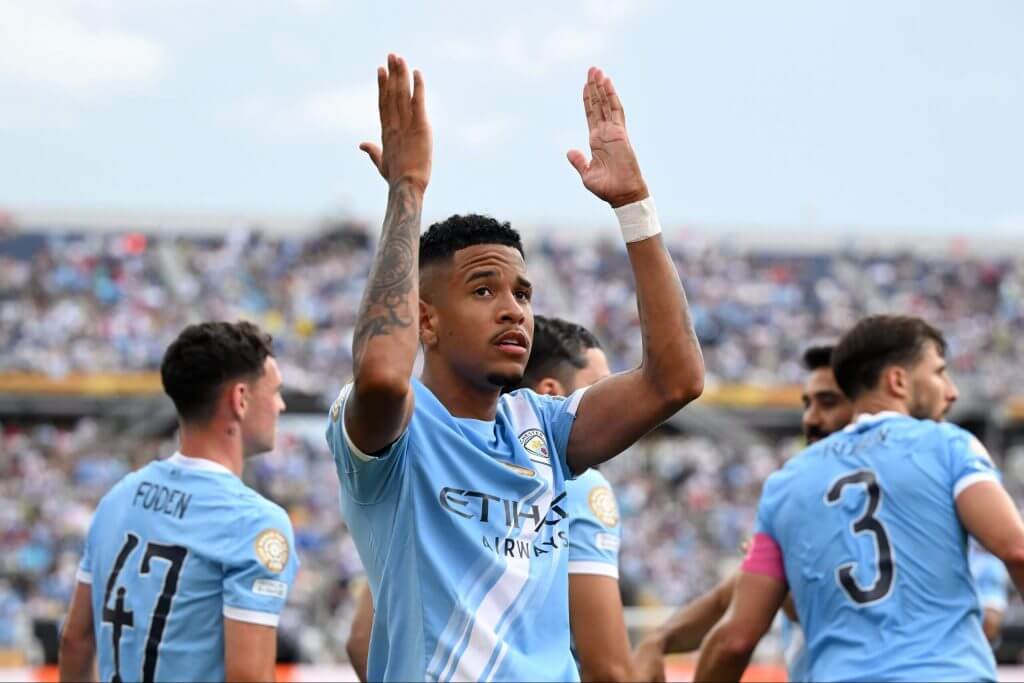
City do not want to sell Savinho (Sven Hoppe/picture alliance via Getty Images)
Which players could be leaving?
Spurs have now moved on most of their talented young players for loan spells, where they will play more football.
That means that the squad is starting to take shape for next season, although Dane Scarlett, who has been earmarked for a loan, is still there.
The final question relates to more experienced senior players, such as Yves Bissouma and Richarlison. If they go, then Spurs might have more space to bring more players in, but so far, nothing has happened.
Jack Pitt-Brooke
Why have some Premier League sides spent so little this summer?
The usual names dominate spending this summer, but it is worth a look at those occupying the other end of the scale.
At Crystal Palace, the £2m signing of left-back Borna Sosa from Ajax comprises their only spending. Ten miles north west, purse strings have been even tighter: Fulham’s only signing has been 34-year-old backup goalkeeper Benjamin Lecomte, arriving from Montpellier for less than £500,000.
Palace’s lack of spending looks hard to unravel from their recent ownership upheaval. For all the drama John Textor’s presence brought to proceedings, he also brought plenty of funding; Palace’s cash from its owners ticked up notably during his time, with £30m or more pumped in in each of the past four seasons.
Those Textor has left behind are hardly poor but Palace pre-Textor always had a focus on financial sustainability. Save for a £24m injection in 2018-19 to help fund hefty transfer instalments, owner funding before his arrival was minimal, particularly by Premier League standards.
Palace weren’t in any danger of a profit and sustainability rules (PSR) breach this summer, but losses have leapt in recent years and are near £200m since the onset of the pandemic. Last season’s sales of Michael Olise and Joachim Anderson brought in big money, but Palace boast neither spendthrift owners nor huge revenues.
At Fulham, Shahid Khan has spent lots during his 12 years at the helm, but the building of the new Riverside Stand has sapped resources. In four seasons from 2020-21 to 2023-24, Fulham spent £211m on infrastructure projects.
Khan is hardly short, but Fulham need revenues to flow from that build for a couple of reasons. Like Palace, they were fine on PSR last year, but there’s a looming threat. Fulham’s 85 per cent wages-to-revenue ratio was the third highest in the Premier League in 2023-24 and, though the division will continue to operate a version of UEFA’s ‘squad cost’ limits in shadow again this season, there’s a need to have an eye on the future. Fulham’s frugal summer is unlikely to be entirely agnostic of such considerations.
While neither of those two have spent much, five others have sold more than they’ve bought. Propping up the net spend table are Bournemouth, whose net £70m income this summer is only set to increase with Illia Zabarnyi’s big-money move to PSG confirmed today.
Of those five clubs, four, including Bournemouth, finished between seventh and tenth last season. Nottingham Forest, Brighton and Brentford have all made net income of £35m to £40m this summer and, in the case of the latter two, successful player trading has been key to recent rises up the English pyramid.
Brighton spent heavily last year but have returned to being bigger sellers than buyers. They, like those around them, essentially have to trade their way up the table, as they don’t boast the big non-transfer revenues of some others.
Last season’s mid-table sides are generating plenty in sales this summer, but their ability to progress further will be dictated by how well they’re able to reinvest it — especially at Bournemouth.
Chris Weatherspoon
Barcelona
What happened this week?
Barcelona finished their pre-season with a 5-0 win against Serie A side Como to claim the Joan Gamper Trophy, with Lamine Yamal and Fermin Lopez scoring two goals apiece.
There have been plenty more off-pitch issues in the past week, though. Marc-Andre ter Stegen was stripped of his captaincy on Thursday after refusing to allow Barca to share his surgery reports with La Liga, with the club looking to use a rule regarding injured players to register a new signing under the league’s salary limit regulations.
If La Liga’s medical panel consider Ter Stegen’s back injury to be long-term — i.e. it deems the German to be out for at least four months — Barca would be allowed to use the equivalent of a significant chunk of his salary to register one new player.
The 34-year-old took a step back a day later, posting a statement on social media in which he said he was keen to cooperate with the club and gave his consent for them to file his medical reports to La Liga. As soon as that happened, Barca released a new statement on Friday night, reinstating him as team captain.
Ter Stegen spoke to fans at the Estadi Johan Cruyff before the Joan Gamper game and said he was happy to leave his problems with the club behind.
There was also an unexpected move: Martinez left to join Al Nassr in the Saudi Pro League. Al Nassr offered the 34-year-old centre-back a significant salary improvement, and Martinez left for free, per a ‘gentleman’s agreement’ between player and club last summer when he had received another lucrative proposal from the Saudi Pro League.
Barca agreed to show openness to let him go if a new offer came in this summer, as was the case here. Martinez did not feature in the final two games of their pre-season tour in South Korea with negotiations ongoing at the time.
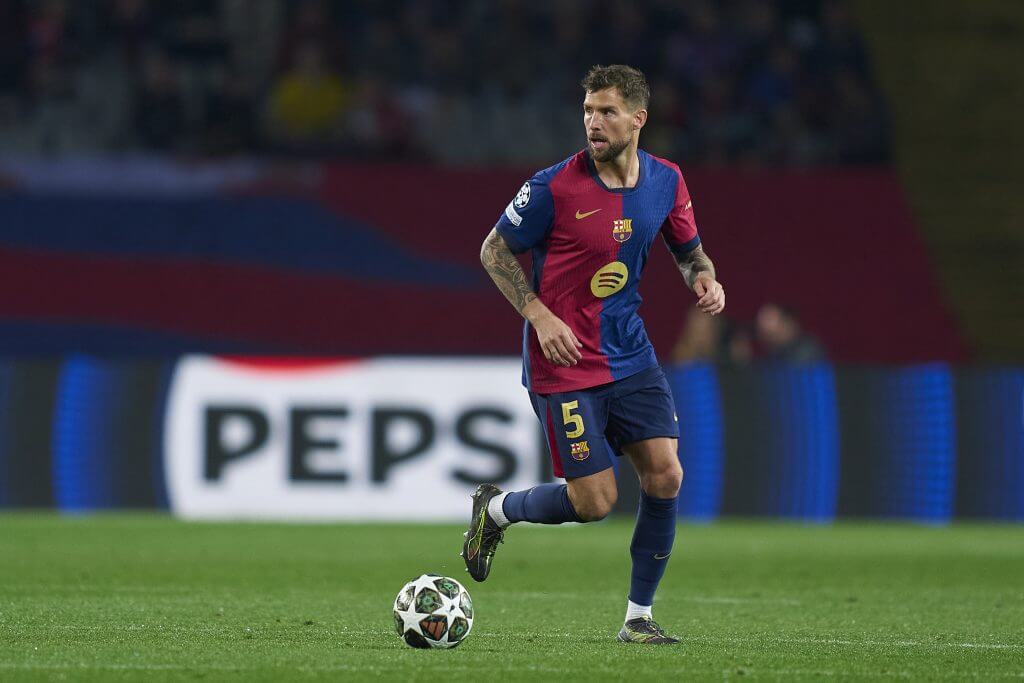
Martinez has moved to Saudi Arabia (Pedro Salado/Getty Images)
How much of a financial boost is Martinez’s exit?
Barca sources say Martinez’s exit takes off €14m from their wage bill for this season. But the Catalans will not be able to use all of it to register their new signings. As they are still spending above their salary limit, La Liga does not allow them to spend every euro of new income freely (the so-called 1:1 rule), so they can only use 60 per cent of the salary space freed up by Martinez for new signings.
The club admit that it will not be enough to get all the new registrations done. Barca are still waiting for money from the VIP seating sale they agreed in January to be approved by their auditors and counted as part of their budget.
Barca believe they should be in a strong position once that is approved, but there is no indication this will happen before the end of the week, with the first game of the season against Real Mallorca on Saturday.
For now, new signings Joan Garcia, Marcus Rashford and Wojciech Szczesny (following his short-term deal last season) are not registered, and therefore cannot play in that game. Fellow new arrival Roony Bardghji isn’t either, but he could be approved as a reserve team player. Club sources say left-back Gerard Martin also needs to be registered as part of the first team after being promoted from the second team, Barca Atletic, last season.
What positions/players are they still looking at?
Hansi Flick said after the Como win that he does not expect the club to make any signings to replace Martinez. “I will speak with Deco when he’s around here, but for now I don’t think any new signing will come in,” he told Catalan television station TV3.
Barca are not actively working on more signings as they believe all positions are well-covered. In Martinez’s absence, players such as Ronald Araujo and Andreas Christensen are expected to step up and fill the gap.
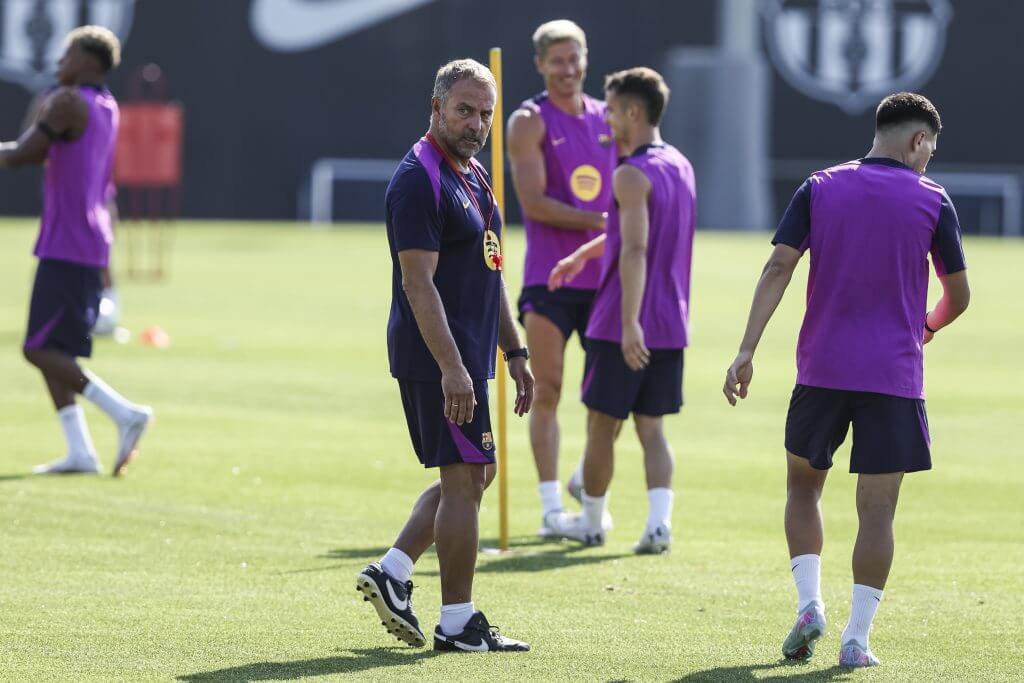
Flick does not expect Barcelona to sign a replacement for Martinez (Javier Borrego/Europa Press via Getty Images)
Which players could be leaving?
Goalkeeper Inaki Pena has been on the list of potential departures since the start of pre-season. The 26-year-old is expected to leave, with all parties involved agreeing it is the best solution for him.
Barca sources and voices within the player’s camp say there have been approaches from multiple clubs, including Como and Celta Vigo. But Barca are hesitant to let him go before they register their new goalkeeper Garcia, who signed from local rivals Espanyol earlier this summer.
As things stand, Pena is the only first-team ’keeper registered for Barca in La Liga — and therefore the only one who could play on Saturday. Club sources expect to make progress with Pena’s exit as soon as there is progress with registrations.
The club have also allowed 19-year-old right-back Hector Fort to look for more playing time elsewhere. They are open to letting him go on loan or move permanently, but would look to keep a buy-back clause. Jules Kounde and Eric Garcia are ahead of Fort in the pecking order.
And finally there is Oriol Romeu — yes, he is still a Barca player. They signed him in 2023, and he is entering the final year of his contract. The club plan to agree to a contract termination with him and he is in talks with other teams, including Girona — who Barca signed him from, and where he spent last season on loan.
Pol Ballus
Real Madrid
What happened this week?
The main news was academy graduate Gonzalo Garcia’s renewal until 2030, making him a first-team player. The Athletic reported in the previous edition of The Transfer DealSheet that his agent was in talks with the club over the extension.
The club have rewarded the 21-year-old striker for his impressive performances at the Club World Cup. He arrived at that tournament with plans to leave in search of more playing time — with Getafe then very well positioned to sign him — but ended it as top scorer with four goals and an assist in six games.
Xabi Alonso’s confidence in Gonzalo was a key factor in the decision, especially given doubts about his playing time with Endrick coming back from injury. The young Brazilian has been handed Madrid’s iconic No 9 shirt, as first revealed by The Athletic, despite reports suggesting it would go to Gonzalo.
Gonzalo will wear 16, while summer signing Franco Mastantuono will be given the only remaining number, 25. The Argentine, who was signed from River Plate in June for around €63.2m, is expected to be officially unveiled on Thursday and will take the final spot in Madrid’s 25-man La Liga squad.
Reinier Jesus’ exit to Atletico Mineiro on a free transfer was also officially announced. The 23-year-old Brazilian midfielder left without having made his first-team debut after Madrid paid Flamengo €30m for him in 2020. The Spanish club retain a 50 per cent sell-on clause.
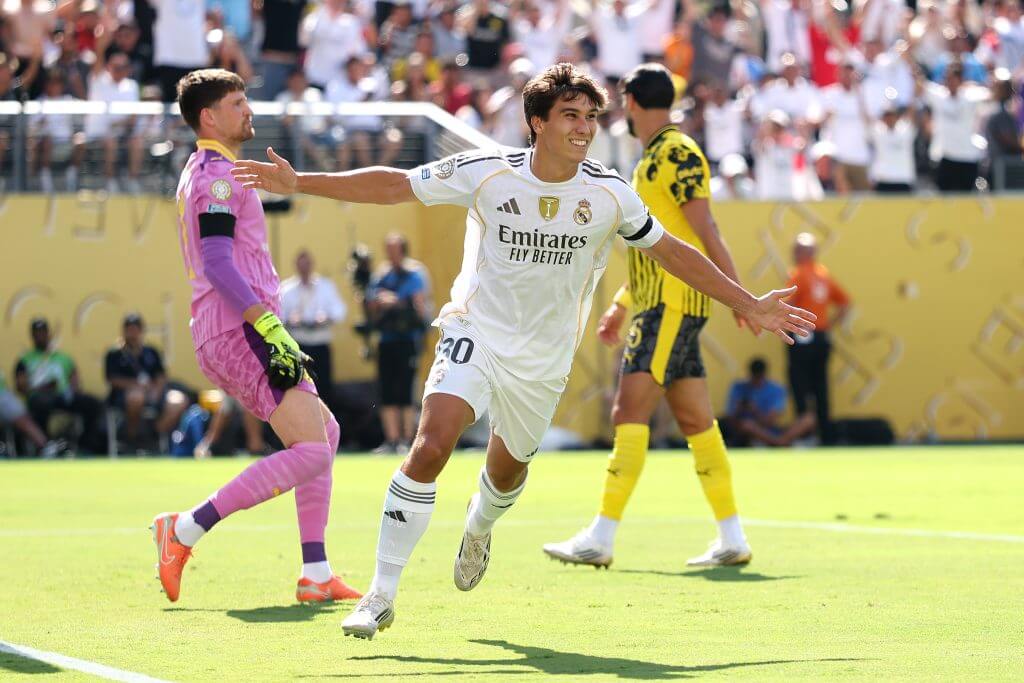
Garcia has signed a new contract with Madrid (Getty Images)
Why does Alonso’s opinion of the squad’s readiness differ from the club’s?
Firstly, because coaches generally always want more signings, while the board, who are responsible for balancing the books, are more cautious.
Senior Madrid sources say that each position is covered by two players, all 25 places in the team’s La Liga squad are filled and that nobody wants to leave. Alonso understands the situation but would ideally like more reinforcements.
What positions/players are they still looking at?
None actively. If there are no further exits — and no player has indicated a desire to leave at this point — there is no room for new arrivals.
Which players could be leaving?
For now, nobody has expressed an interest in leaving.
“I don’t think the squad is closed yet,” one anonymous player told The Athletic, saying that with every position filled, some players will barely be given any playing time.
People at the club are keen to see David Alaba or Ferland Mendy leave, but are pessimistic about their chances of offloading them.
Alonso and his staff would also welcome departures if it would help bring in new signings. Rodrygo is not expected to be a key player this season under the coach and the club’s plans, with Premier League clubs interested in him.
Some at Madrid believe a lack of playing time for certain players at the start of the season could lead to some movement, but that is just a feeling behind the scenes at the club.
Mario Cortegana
Would a Premier League side benefit from signing Rodrygo this summer?
In Real Madrid’s star-studded attack, Brazilian winger Rodrygo can often feel like the forgotten man. With the club now open to selling him, it seems he’s not at the forefront of Alonso’s mind either.
While he hasn’t always matched the ludicrously high standards set by Kylian Mbappe, Jude Bellingham and Vinicius Junior, that shouldn’t obscure the fact that he is a hugely talented player in his own right.
Rodrygo’s attacking numbers last season — six goals and five assists — don’t leap off the page. But that was partly due to the more selfless role he played under Carlo Ancelotti. Shunted to the right to make room for Mbappe, he gave up his most prolific position on the left for the good of the team.
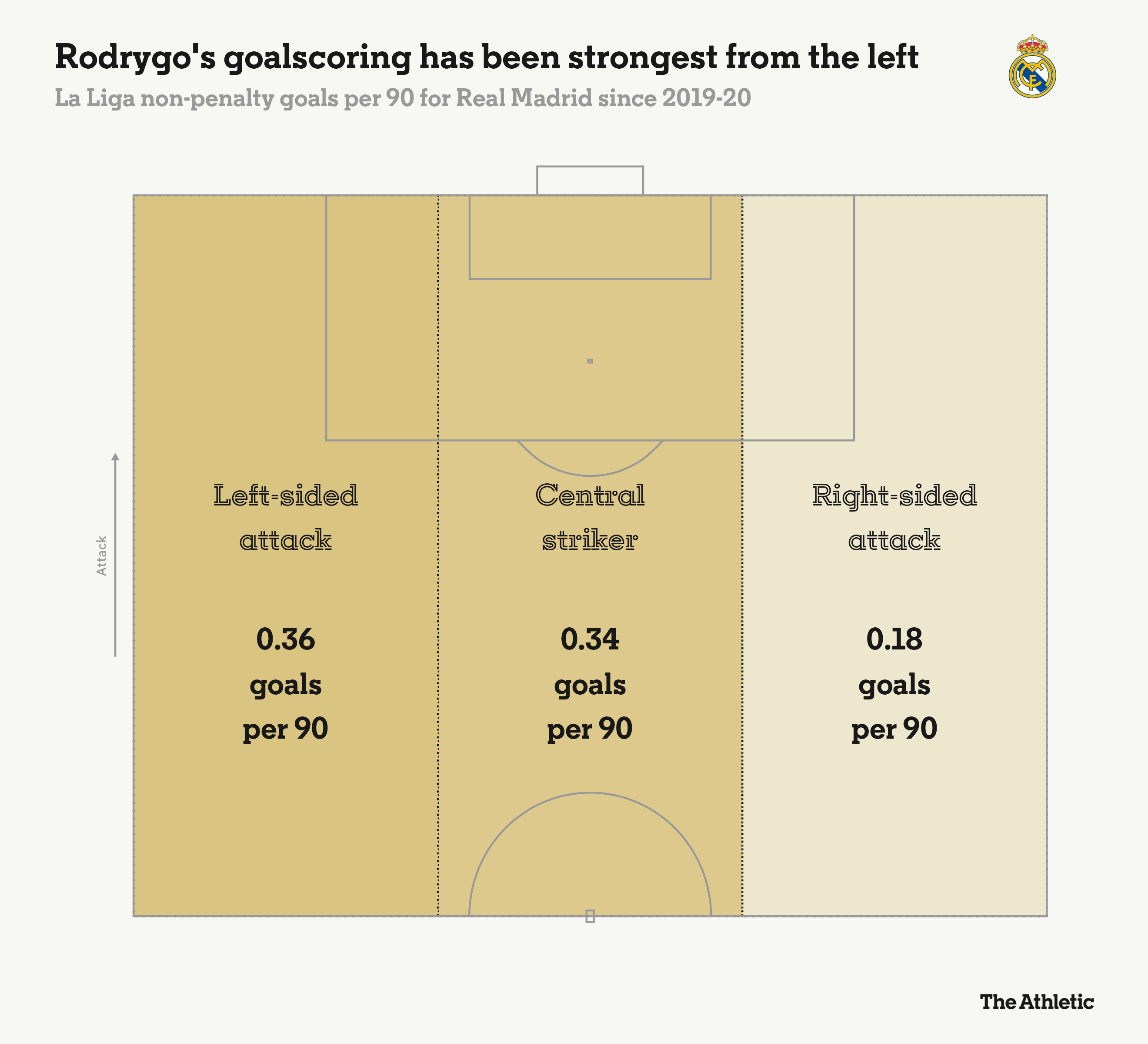
His versatility has been invaluable for Real Madrid, filling in across the width of the pitch, and on occasion even playing centre forward. It speaks to the multi-faceted nature of his game that he remains effective wherever deployed.
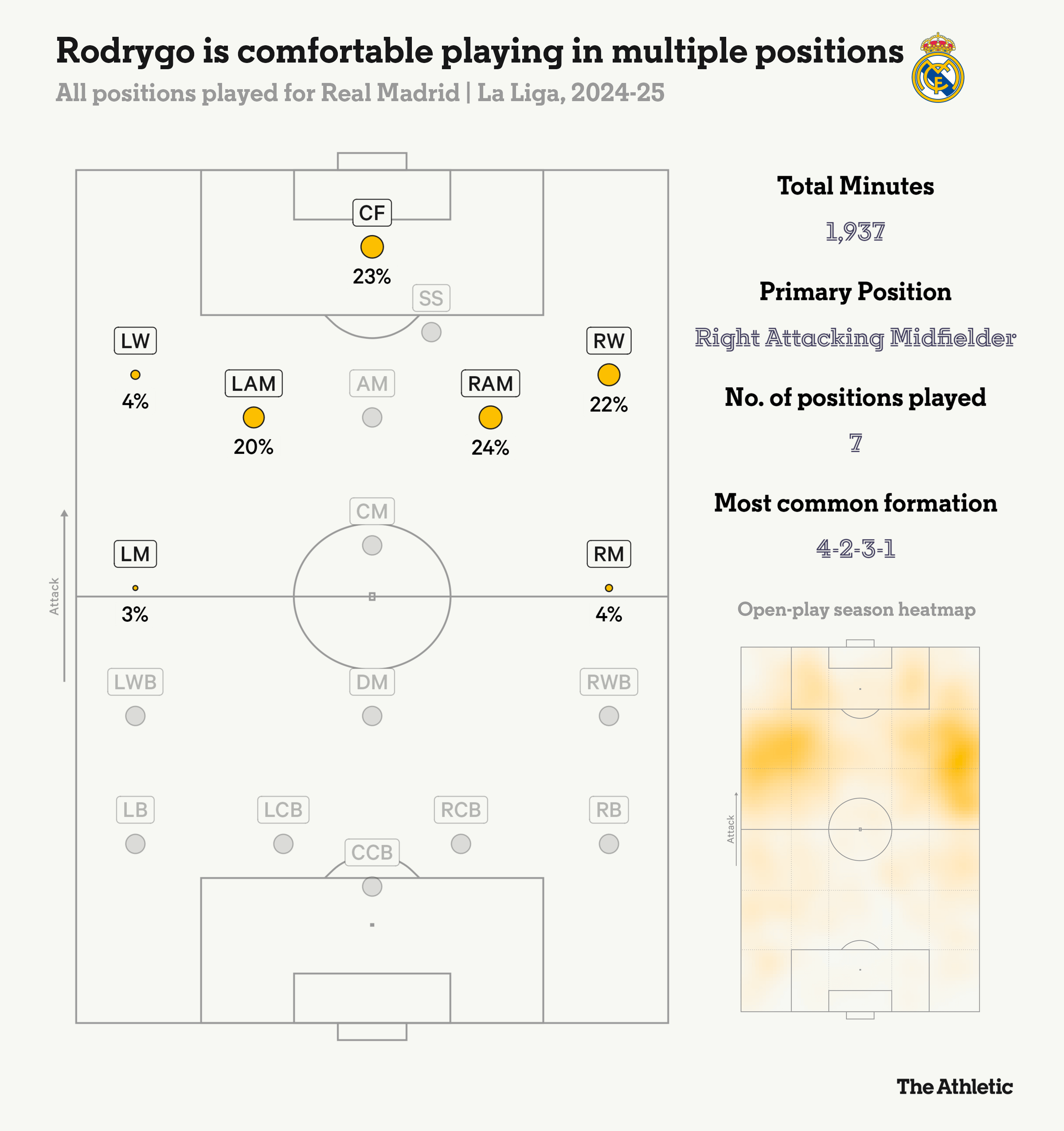
Rodrygo is a skilful ball carrier — ranking 12th in La Liga last season for successful take-ons per 90 — and he drives his team upfield with invention. His relentless work off the ball allows his more illustrious team-mates to conserve energy for decisive moments in attack.
There are few attacking talents as well-rounded as Rodrygo at the sharp end of the game. Real Madrid might be about to offer up one of the bargains of the summer.
Conor O’Neill
(Top image — Illustration: Dan Goldfarb / The Athletic; Mike Hewitt, George Wood / Getty Images)
